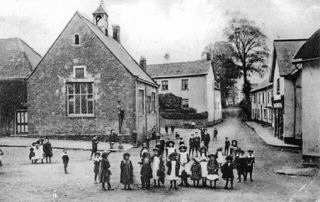Lots of other stories are contained in the 1911 Census and it’s predecessors. Lots
of familiar village names are there too. Explore and lets have your stories!
On the right will be seen a map with boxes near to, or pointing to, streets, houses,
pubs or farms. Clicking on the links within the boxes will show the census details
for 1911. Hopefully the placement of the links on the maps are correct but there
has been a certain amount of guesswork involved and the author is unsure about, amongst
others, The Hawthorns, The Laurels and Welsh Cottages. If you know please email!
In the future it is intended to develop this further with photos from then and now,
etc.
The bare listings are accessible on Google Docs. You can see them arranged by address
here or by surname here
Silverton in 2011 is a very different place than it was a hundred years ago. In 1911 there were no mini-roundabouts, no bus-shelters and children could probably stand safely in the middle of the Square without much fear of being run over. The building left of centre below was then The Boys School and it had a gable; not the half-hip it has now. The Schoolmaster was John Alexander Fallon who was at the time, 58 years old. He hailed from Cork in Ireland and had married Lucy in about 1882. She came from Newton Poppleford and their daughter, Ethel, had been born in Silverton in about 1888 and, in 1911, also taught at the school.
So what else can the 1911 census tell us about Silverton in 1911?
About 160 people worked, or had worked on, the land. This was about 14% of the parish population.
There were some 131 children (12% of pop.) at school.

The population of the village itself was some 690 people whereas Ellerhayes, as it was then, housed some 69.
Where did they and for those maybe in turn, us, come from? Some 361 people were born in Silverton with 219 more being born within 10 miles. 440 people were born elsewhere in Devon. A significant number of the remainder came from Somerset with South Wales and London being well represented.
Only 2 people were born away from the British Isles. Lily Selway, who lived in Fore Street, had been born in Halifax, Nova Scotia 12 years before. The then Vicar’s wife, Clare Europa Tormley Heathcote, was born in Gibralter. 20 miles south and her second name might have been “Africa”! She was 55 in 1911 and the Rectory then was Prispin House. Their Coachman, William Tucker Perkim would drive them down Coach Road to the Church.
